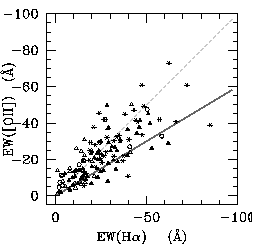As published in:
``Building Galaxies: from the Primordial
Universe to the Present''
eds.: F. Hammer, T.X. Thuan, V. Cayatte,
B, Guiderdoni, & J. Tran Thanh Van, 2000, p. 33-36.
THE NEARBY FIELD GALAXY SURVEY:
A Spectrophotometric and Photometric Study
of 196 Galaxies in the Local Field
Rolf A. Jansen 1,2
1 Kapteyn Astronomical Institute, Groningen, The Netherlands.
2 Harvard-Smithsonian Center for Astrophysics, Cambridge, USA.
Abstract
|
I report on the results of an optical spectrophotometric and photometric
study of 196 nearby galaxies, that form a representative sample of the
local field population. Integrated (drift scanned) and major axis
(pointed) spectra were obtained, as well as UBR surface
photometry to aid in the interpretation of the spectroscopic data.
Follow up observations include high resolution spectra ([8], internal kinematics) and HK NIR surface
photometry ([10], dominant stellar
population). |
Introduction
With the advent of 8 m class telescopes a flood of spectroscopic,
photometric, and morphological data has become available on faint
distant galaxies. For the first time, information can be obtained on
normal galaxies or even -- perhaps -- their progenitors. No longer is
study restricted to the very brightest objects: instead, galaxies are
routinely sampled well down the galaxy luminosity function. |
The Sample Galaxies were selected from the first CfA redshift
catalog ([4], CfA I), which contains 2400
galaxies to a limiting blue photographic magnitude of 14.5 . The
CfA I has several virtues: (1) it is nearly complete within its
selection limits, (2) it contains galaxies with a large range in
absolute magnitude, and (3) all galaxies have been morphologocally
classified. |
Observations
Observations were made over a period of 4 years at the F.L. Whipple
Observatories 1.2 m and 1.5 m telescopes. The former
telescope is dedicated to CCD and NIR array photometry; the latter, with
the FAST spectrograph to spectroscopy. |
Photometric properties We [5] reproduce the well-known
trend of absolute magnitude with type for the morphological types later
than Sa. There are not many very bright very late type galaxies. We
find a significant number of low luminosity early type systems. In a
plot of the effective B-R color as a function of type, the
bulk of the galaxies follow a strong trend: galaxies become
progressively bluer towards later types. |
Spectrophotometric results
Common knowledge dictates that the optical spectrum of an elliptical
galaxy is dominated by old stars and shows no line emission; the
spectrum of an intermediate type spiral -- say Sb -- has a roughly flat
spectrum and a modest amount of nebular Balmer, Oxygen, Nitrogen and
Sulphur emission lines; and that of late type galaxies should have a
blue continuum and lots of nebular emission. |
[O II] 3727Å as a tracer of the current SFR When H |

|
Figure 1: [O II]
as a function of H EW. EW.
|
|
The driving `force' for this effect appears to be metallicity. Lower
luminosity systems tend to have lower metallicities, resulting in a less
effective cooling of the interstellar medium and a higher average
temperature. Despite the lower abundance, the [O II]
line will be boosted in strength with respect to H |
References[1] Carter, B., & Fabricant, D. G., (in prep.)[2] Fabricant, D., Cheimets, P., Caldwell, N., & Geary, J., 1998, Publ. Astr. Soc. Pac. 110, 79 [3] Hammer, F., Flores, H., Lilly, S. J., Crampton, D., Le F\`evre, O., Rola, C., Mallen-Ornelas, G., Schade, D., & Tresse, L., 1997, Astrophys. J. 481, 49 [4] Huchra, J. P., Davis, M., Latham, D., & Tonry, J., 1983, Astrophys. J. Suppl. Ser. 52, 89 (CfA I) [5] Jansen, R. A., Franx, M., Fabricant, D. G., & Caldwell, N., 2000a, Astrophys. J. Suppl. Ser. 126, 271 [6] Jansen, R. A., Fabricant, D. G., Franx, M., & Caldwell, N., 2000b, Astrophys. J. Suppl. Ser. 126, 331 [7] Jansen, R. A., 2000, Ph.D. thesis, University of Groningen [8] Kannappan, S. J., Fabricant, D. G., & Franx, M., (in prep.) [9] Kennicutt, R. C. Jr., 1992, Astrophys. J. 388, 310 [10] Pahre, M., Jansen, R. A., Kannappan, S. J., Fabricant, D. G., & Willner, S., (in prep.) [11] Schaerer, D., 1999 (these proceedings) |
Last updated: Apr 15, 2000